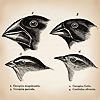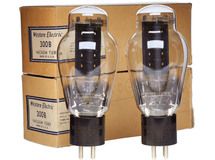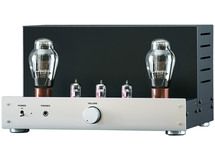-
Posts
122 -
Joined
-
Last visited
Content Type
Forums
Events
Gallery
Everything posted by jtice
-
In that case I’d not paint them. Original in good condition is the most valuable. But if you gotta have black for some reason, and are willing to make them non-original… personally I wouldn’t buy black klipsch at all. Just not my aesthetic. Love the golden oak veneers the most.
-

Vintage Receiver or New Integrated Amplifier for La Scala's?
jtice replied to Peacemaker's topic in 2-Channel Home Audio
There are many tubes available for either, and the tubes will have their own sound characteristics, so it's hard to generalize. 300B is going to deliver more power, so it may feel punchier, able to play louder, more overhead. The 2A3 may be a bit warmer and rounder, but again it's dependent on the specific tubes. I have not owned a 300B, only the 2A3 that I built from a Bottlehead kit in 2012 and have been very, very pleased with. If you can solder and follow clear directions you can build one of these, and they are really good. Their flagship model is now a 300B integrated (used to be 2A3 monoblocks). The 300B tube is renowned for its quality sound, and they can get pricy (you probably don't want to know... think down payment on a house). But you can buy quality 2A3 tubes for a mere $250 or so per pair –– almost like they're giving them away. I'd really like to build a 300B myself, but the cost (esp. w/ better tubes) is hard to justify when I already have such a sweet sounding 2A3. There is also a 300B by Elekit that is said to be excellent, with big *** iron. I'd say if you've got deep pockets and enjoy spending it, go with 300B. -

Vintage Receiver or New Integrated Amplifier for La Scala's?
jtice replied to Peacemaker's topic in 2-Channel Home Audio
It's somewhat dependent on what type of music you listen to, and at what volume levels. If you're a jazz/acoustic/folk/classical guy go for a SET, either 2A3 or 300B. In my opinion these amps paired with Lascalas are a match made in heaven. Also, the Decware Zen Triode would be a wonderful match (although I haven't heard one in person). Lascalas need a refined signal because they don't do a damn thing to tame a hard, edgy sounding amp. They also don't need more than a few watts –– you're always going to be listening to less than 1 watt (for home use). The class A amps are so sweet, but they can't make them do 200w so that's why there are A/B amps. Take advantage of the fact that a class A is all you need (assuming you aren't metalhead). I've used push-pull with mine and they are okay... then I got the itch to build a 2A3 and never looked back. 3.5w per channel, detailed and smooth, with tonal qualities... you just need to hear one. -

Denafrips Ares Resistor laddter DAC - anyone?
jtice replied to tigerwoodKhorns's topic in 2-Channel Home Audio
I have an Aries II that I've been listening to for only 10 days. It's amazing. I don't know how much better the more expensive versions could even be. I feel like I made a 30 percent jump from the Wolfson DAC in my CD player. I'd consider the Pontus, but could it be THAT much better? -
I have LaScalas and also had Hereseys for many years. They don't really sound the same or even similar, which I interpret to mean very close. Of course that doesn't mean they aren't compatible. They both have the heritage horn characteristic but each has it's own identity as well. If I were you I'd give it a try as long as you're buying them rightthen if you don't like it you can get your $ back out of them or use them in a second system. If they don't sound right you probably won't be happy with anything less than a third LaScala.
-

Klipsch Forte w/ MiniWatt? Great synergy?
jtice replied to electriceye's topic in 2-Channel Home Audio
I would have to opine that it is worth the trouble. I have used two restored vintage integrateds for ten years, a Scott 299b and a Eico HF-81. Both have delivered much satisfaction for the dollars invested. You can probably find a good one already restored, and this forum is a good place to find one. I haven't heard the Miniwatt product but reviews seem to be lukewarm and qualify positive remarks with "for the tiny size" and "for tiny bucks." Your Forte speakers are efficient enough, but if I were going to go for a flea-powered amp it would be a 2A3 SET, which you can read about on this forum. These are famous for their clarity and warmth for vocal, jazz, acoustic, etc., but may lack the rattle the windows kind of slam a rock n' roller would demand. The vintage integrateds such as the Scotts give you the smooth, warmth of tubes and headroom (with efficient speakers) for any type of music. I seldom crank my 299 above 2 on the volume pot and never above 3. Bottlehead makes kits for 2A3 SET amps that have a great reputation. They have one called Stereomour, which is essentially their former Paramour monoblocks condensed as an integrated package for $750, so that may be a good option if you're really interested in a flea powered amp. For low-cost instant gratification and just over a hundred bucks, you could give a Topping Class T a try. -
There many variables but for your budget, and to pair with Chorus, and esp. if this is your first foray into tubes, I'd suggest a Scott 299 integrated. I've been quite happy with mine for several years. Admittedly my ears are not as sensitive nor my budget as healthy as many who might consider this an all too obvious entry-level solution. Your budget is just about what you'd expect to pay for a nice one rebuilt. I also have a factory Eico HF-81 which was all the rage when I first got into it and the Scott has better dynamics and cleaner high-end in my setup. I have been quite satisfied with the Eico paired with Heresy IIs as a secondary system. I finally feel that I hit low-cost nirvana by adding a SVS 10" foundation under the Lascalas. I have friends with tens of thousands invested and they all say it's amazing what I have put together for under $2k. SETs are really interesting and I am tempted to give them a try myself, but you have to be willing to accept the limitations and I doubt that the Chorus is the speaker for that experiment, especially if you listen to music that needs punch at times. And good ones would probably require a bigger budget. Cornwalls and SETs are said to be a good match for jazz.
-
Our new dog, Zuni. A sweet pup, but more than a handful. Almost 5 months, sings with the piano, can't stand rap.
-

so, i got la scalas today.. (not as impressed as i thought i'd be)
jtice replied to tofu's topic in 2-Channel Home Audio
Sorry, double post. Can't delete it. -

so, i got la scalas today.. (not as impressed as i thought i'd be)
jtice replied to tofu's topic in 2-Channel Home Audio
Pffffffffffffft. -

so, i got la scalas today.. (not as impressed as i thought i'd be)
jtice replied to tofu's topic in 2-Channel Home Audio
I just today changed out my old AL networks for Type A's and the difference is significant. I think you should change networks and listen through a tubes in a large, rectangular room. A square room is probably the worst and 11' is small. Also try them out from the corners about 4-5'. John -
There was a thread that ran a year or two back which generated lots of good jazz recommendations and a couple of folks compiled them and put up a web page. There is also a downloadable Excel file. So if you'd like an instant list of recommendations go here.
-
Gary- here's what I found: The George Cables Trio, tenor saxophonists, Wayne Escoffery, Jimmy Greene and Jerry Weldon will perform The Music of Dexter Gordon, the great master of bebop tenor saxophone, in these cities: February 24, 2005 Blacksburg, VA February 25, 2005 Fairfield, CT May 13, 2005 Detroit, MI May 14, 2005 Milwaukee, WI Allan- Cables was nothing short of amazing. He made his way on stage with a cane and his voice wasn't very strong, but when he started to play it was both sensitive and powerful. The others left the stage while he played a long beautiful solo. And the crowd fully appreciated his talent. John
-
Thought I'd let y'all know about this - if you get a chance don't pass it up... a production of Jazz at the Lincoln Center, Music of the Masters. The Music of Dexter Gordon. Three most excellent tenor sax players accompanied by a trio of jazz legends associated with Dexter and others. I won't go on and on, but it was probably the most jazz talent ever to blow through this little town, and probably the best program I've seen (which isn't really saying much). The audience was into it, they were into it, acoustics were outstanding. George Cables was the leader and host. Two and a half hours of pure musical bliss. George Cables, Piano; Rufus Reid, bass; Leroy Williams, drums; Jerry Weldon, Tenor Sax; Jimmy Greene, Tenor Sax; Wayne Escoffery, Tenor Sax.
-
Lynn, thanks for the pricing info-that really helps. Looks like I'm in pretty good shape on the corners with only one being short of 4' and then only by a inches. D-Man, I think the short side may be preferable in most circumstances. There are differing opinions of course, but George Cardas recommends the short wall as do several others. But they aren't talking about Khorns either. My short side is 12' so I think it will work out fine. Cardas Method
-
---------------- On 5/18/2004 5:21:51 PM rtaylor wrote: Hi, sorry to cut in but what would you lose in bass response by not having the Khorn in a corner? Say you have a set of Lascalas and you replaced them with Khorns facing straight away at your listening position. Would you get close to the same amount of bass, less or more?? ---------------- Khorns use the wall as an integral part of the bass horn. It would be like having a big ole woofer without a cabinet. I think you'd be much better off with LaScalas if you cannot get the Khorns into a descent corner.
-
Looks like I may be in luck. My best two corners are on the short wall of a long room 44" to the door jamb. The door is in the center between the good corners and is 48" wide. Anybody know how a large door between the horns will affect the sound?
-
What size corners are necessary to make Khorns do their magic? I'm looking at a pair locally, the first I've seen within driving distance in a very long time. I have a room with four good corners, except there are doors and windows at various distances. Maybe some of you who have plenty of experience with such things can give me a barely adequate to optimal range. And while you're handing out advice, what's the price range for a pair of nice Khorns, stock with a few minor blemishes? Thanks, John
-
I have a pair of Heresy II's in a long room on the short wall, about a foot from back and side walls. I made speaker stands (and filled them with sand) to get them elevated to ear level. I have them pretty tight to the corners which helps reinforce bass. I bet a small sub would round it out nicely. The room dimensions are close to the golden ratio and even though bass is shy they have a very smooth, unified sound. Room interaction is what placement is all about, so you just have to experiment. Have just doubled the pleasure factor in my 20x24 office/listening room. I had a pool table in the room which dictated everything. The LaScalas were placed on each end, so even though I had a clear path from each speaker to the sweet spot, the speakers were physically separated. I sold the pool table this week and today I worked with speaker placement. I'm finding that about 55 inches from the sides walls and 46 from the back wall just makes them come alive. I have them on the 20 foot wall with a little more than 9 feet center to center and 10 feet to the chair. I used the clapping method (forget the real name) to find the point where the resonance changed and worked from that point. Depending on your room size and shape it may work with the Heresy's. I've tried the golden ratio method and it's not magic in my squarish room. I'm sure you must know all about the various methodsif not I can post links. John
-
Jbosborn, I bought one about a year ago very much the same way you didnever having actually heard one. I had Craig do a full rebuild. It had a bit of hum at first but it was silent when I got it back. My recommendation is to go for the full rebuild because it will probably sound better and so you'll know it's right and have more confidence in it. It's a sweet amp and I'm sure you'll enjoy it. John
-
---------------- Regarding the signatures: on my monitor, the reformatted sigs often take up more room than the old ones, and are tough to read as well. ---------------- I agree. Used well, the ability to format type size and color makes for more compact, legible, aesthetic sigs and a more enjoyable experience. I say give back the html and enforce the rules on commercial useage. Don't penalize everyone because of a few.
-
Testing...
-
---------------- On 2/16/2004 2:32:56 PM bdc wrote: I know that, for some reason, people like to look down on Klipsch as an 'audiophile' company even if they've never heard any Klipsch speakersWhy is this? ---------------- It has more to do with people than it does speakers. They have the P&P Syndrome. They acquire it by reading audiophile magazines, believing everything they read, and believing that spendng copious moolah on a stereo is the key to happiness. And music doesn't really fit in that equation. (100 posts and no more newbiea Crazy Poster! That's half right anyway.)
-

Ever listen to stuff you wouldn't tell your friends about?
jtice replied to jtice's topic in 2-Channel Home Audio
---------------- On 2/14/2004 1:49:52 AM jt1stcav wrote: Was a teen in the '70s who grew up on Bach, Franck, and Widor organ compositions played by Hurford, Biggs, and Fox, and was too embarrassed to admit I loved classical organ works to my peers. ---------------- No kiddin I had hardly even heard of Bach in those days. A few references in some of the rock music. Now, I often start the day with Bach. The cello suites is what lit lit my fuseup to four versions. Then sonatas and partitas for solo violin, Goldberg variations... Something about the intricate patterns, energizing yet relaxingand with solo instrumentation. It's almost as if Bach is it's own category of music. I also sampled recordings by Fox and Biggs in the store but chose Hurford because it seemed to have more body, dynamics, better pace. But I was probably only hearing 1/10 of the sound through h-phones. How would you say the Fox and Biggs recordings compare? -
Sixties and seventiesRock'n Roll foreverdisco sucksnever trust anybody over thirty. We swore to never change. Tonight I'm listening to J.S. Bach, The Great Organ Works by Peter Hurford. Man, this stuff kicks serious butt! Toccata and Fugue in D minor, Fantasia and Fugue in G minor, half volume, LaScalas, 299Bawesome sounds. I'll have to go through the house tomorrow and see if any nails worked loose. Ever surprised yourself by discovering something so different that you wonder if it's actually you enjoying it?





